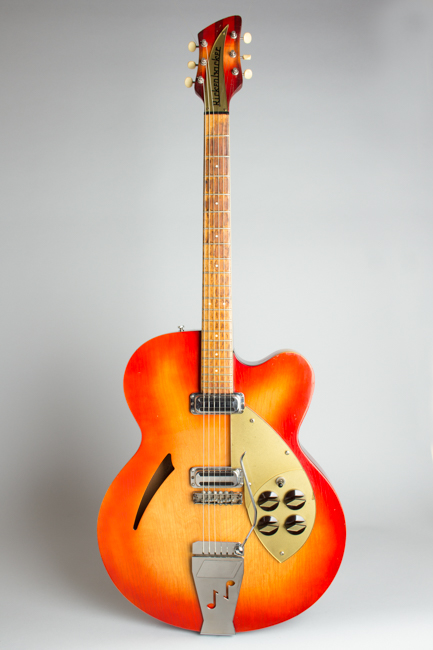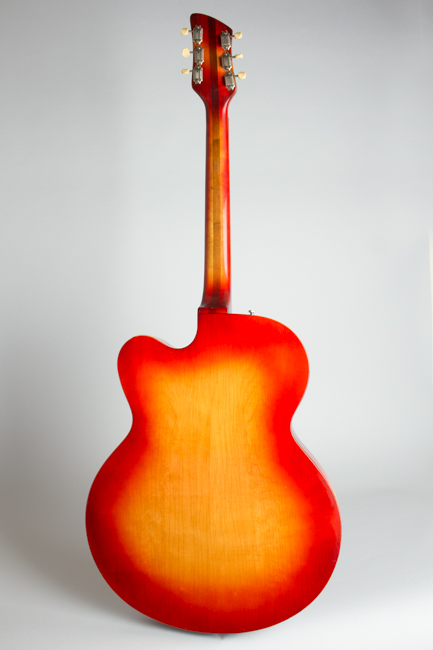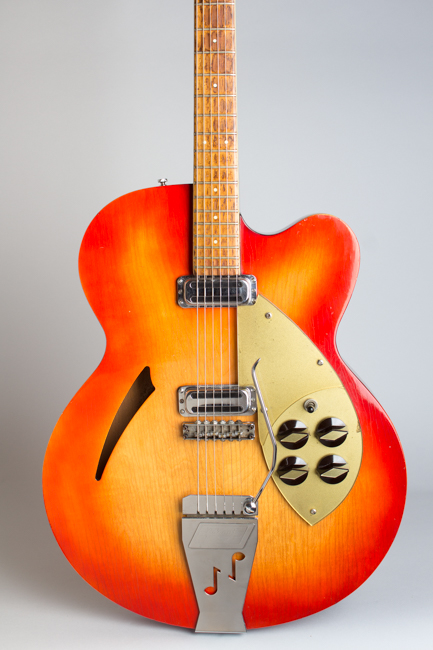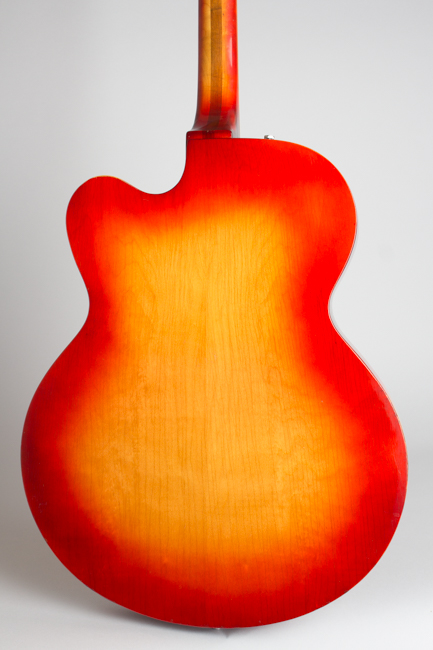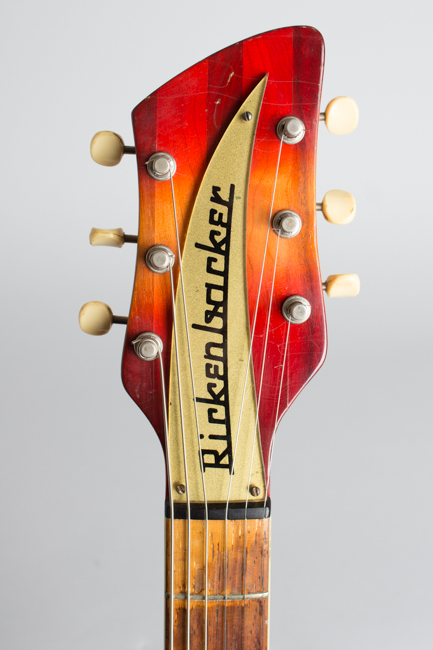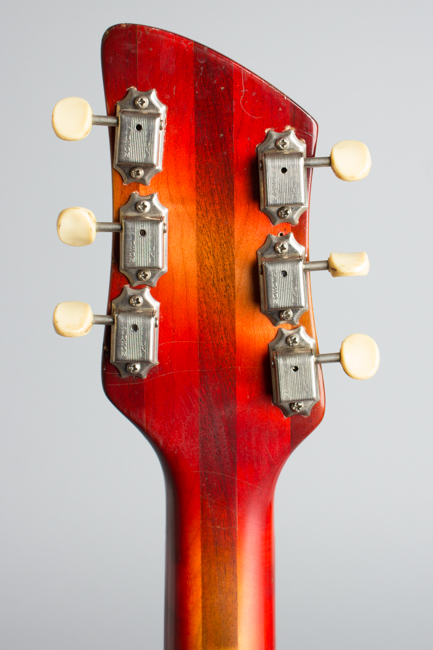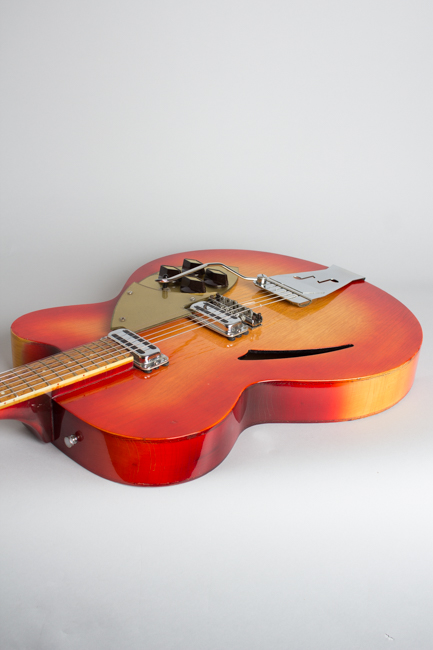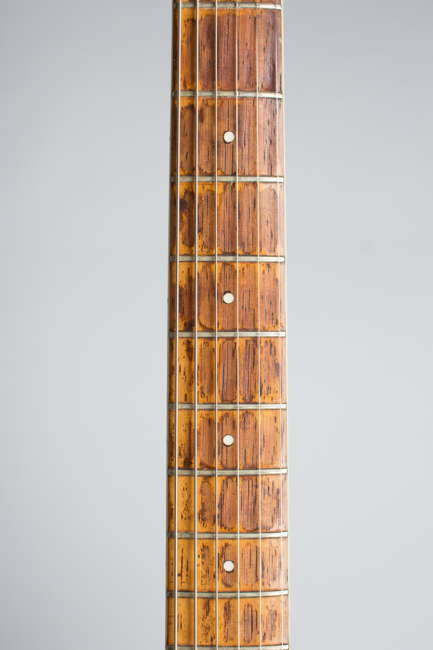Rickenbacker Model 335F Semi-Hollow Body Electric Guitar (1959)
This item has been sold.
Item # 8115
Prices subject to change without notice.
Rickenbacker Model 335F Model Semi-Hollow Body Electric Guitar (1959), made in Los Angeles, Fireglo red sunburst finish, laminated maple body and neck, Padouk fingerboard, black hard shell case.
Rickenbacker has produced a number of iconic electric instruments over the last 80 years; some have become classics of the 20th century guitar history, while others have disappeared into obscurity. This Capri Model 335-F is one of the latter, and also one of the rarest and more unusual! The Rickenbacker 300 F-series "Full Body" models were originally offered as part of the Capri series of thinline hollowbodies starting in 1958, but despite remaining on the price lists well into the 1960s were produced in such tiny numbers as to be effectively discontinued almost immediately.
The "Full body" referred primarily to width rather than depth; the flat-topped hollow body is a full 17" wide but only 2 1/4" deep at the rim. The body shape with the single rounded treble-side cutaway is more traditional (and less striking visually) than the standard Model 310-375 familiar to most players; it was referred to as "semi-cutaway" in the company catalog and may have been intended to woo more conservative players to the Rickenbacker camp.
The guitar's other features are classic late-'50s Rickenbacker, including the "toaster-top" chrome pickups, double elevated gold-backed Lucite pickguard, gold nameplate on the headstock, and adjustable roller bridge. The finish on this guitar is a very early example of what would become the company's most iconic look, the vibrant red-natural sunburst they called "Fireglo". The top and back are not bound, but the cross-grain wood in the ply back is visible from the side and gives the appearance of side binding -- a very unusual effect.
The neck is the standard Rickenbacker laminated maple style with a single truss rod, not the double-rod system used in later models. Unusually for a 330 model, the dot-inlaid fingerboard is bound, while the body is not. This is not the only "F"-model with this sort of anomaly; the prototype 330-F played at the 1958 trade shows by Toots Thielmans has the same combination.
This 335-F has the early 1950s pattern serial number that does not allow precise dating, as it is a cumulative order not a date coded one-Rickenbacker began using a date-coded system in later 1960. It was most likely built in 1958 (the original pots are coded to the 30th and 36th week of that year) shipped around 1960-61, when the Accent vibrato became standard equipment. In this period many of the early Rickenbacker models were held in stock literally for years before finding a buyer, and the company would often refit them with newer hardware as it became available before shipping the instrument out. The long Accent tailpiece on this guitar with decorative music note cutouts was used only on these full-body models.
As well as looking like no other instrument, the 335-F is a unique feeling guitar. The large body with no arching gives it a slightly "flattened" look but otherwise the 335-F plays pretty much the same as more familiar period Rickenbacker Capris. The neck/body joint is far more substantial than the standard Model 330, and the whole instrument has a much more solid feel. The sound falls into the traditional Rickenbacker sonic niche, but with quite a bit of added acoustic depth and warmth due to the much larger body cavity.
The "F" models were prominently featured in the 1958-9 color catalog but sales-wise were far less successful commercially than the more familiar double cutaway Capri models-only a handful of any given model were been produced before the entire series slid into obscurity. The only published production figures indicate a total of 14 Model 335-F's shipped in 1959-61; this is likely one of 6 listed in Fireglo finish and needless to say these are now very seldom encountered. This is a well-used but still good playing example, and one of the very few original "F" model Capris we have ever encountered. This exact guitar is pictured on page 230 of the 1994 book ELECTRIC GUITARS & BASSES-A PHTOGRAPHIC HISTORY by George Gruhn & Walter Carter, identified as a 1958 model.
Overall length is 42 in. (106.7 cm.), 17 in. (43.2 cm.) wide at lower bout, and 2 1/4 in. (5.7 cm.) in depth, measured at side of rim. Scale length is 24 3/4 in. (629 mm.). Width of nut is 1 5/8 in. (41 mm.).
Overall, this guitar remains in played but unmodified original condition; there is some wear and a evidence of careful repairs, but really this is a fine example of an extremely rare guitar. The lovely early Fireglo finish retains very good color -- bright and unfaded with some checking to the top and back, specific to the 1959 period. Rickenbacker improved their finishes by 1960, making them extremely resistant to this phenomenon. In terms of play wear, the body shows only light scuffs, chips, and some denting, while the neck had very little wear to the back, but quite a bit on the fingerboard, where a good portion of the lacquer is worn away.
There is evidence of finish touch-up and overspray all around the heel; it is possible the guitar has had a neck set long ago, or there was a separation at the heel that was repaired. In either case, there are no cracks or breaks to the wood visible. There was a typical, very slight separation of the fingerboard at the nut, which is almost ubiquitous with Rickenbackers of this period. This is cleanly repaired and only really visible on close inspection with UV light.
The hardware and electronics are mostly original, with only a couple of splices to the pickup leads and a replaced pot showing some electronic work in the past. The frets are still original and fairly low, but the guitar is still a good player. This is an exceptionally rare and cool Rickenbacker if an eccentric one, and a unique guitar to play. Excellent - Condition.
Rickenbacker has produced a number of iconic electric instruments over the last 80 years; some have become classics of the 20th century guitar history, while others have disappeared into obscurity. This Capri Model 335-F is one of the latter, and also one of the rarest and more unusual! The Rickenbacker 300 F-series "Full Body" models were originally offered as part of the Capri series of thinline hollowbodies starting in 1958, but despite remaining on the price lists well into the 1960s were produced in such tiny numbers as to be effectively discontinued almost immediately.
The "Full body" referred primarily to width rather than depth; the flat-topped hollow body is a full 17" wide but only 2 1/4" deep at the rim. The body shape with the single rounded treble-side cutaway is more traditional (and less striking visually) than the standard Model 310-375 familiar to most players; it was referred to as "semi-cutaway" in the company catalog and may have been intended to woo more conservative players to the Rickenbacker camp.
The guitar's other features are classic late-'50s Rickenbacker, including the "toaster-top" chrome pickups, double elevated gold-backed Lucite pickguard, gold nameplate on the headstock, and adjustable roller bridge. The finish on this guitar is a very early example of what would become the company's most iconic look, the vibrant red-natural sunburst they called "Fireglo". The top and back are not bound, but the cross-grain wood in the ply back is visible from the side and gives the appearance of side binding -- a very unusual effect.
The neck is the standard Rickenbacker laminated maple style with a single truss rod, not the double-rod system used in later models. Unusually for a 330 model, the dot-inlaid fingerboard is bound, while the body is not. This is not the only "F"-model with this sort of anomaly; the prototype 330-F played at the 1958 trade shows by Toots Thielmans has the same combination.
This 335-F has the early 1950s pattern serial number that does not allow precise dating, as it is a cumulative order not a date coded one-Rickenbacker began using a date-coded system in later 1960. It was most likely built in 1958 (the original pots are coded to the 30th and 36th week of that year) shipped around 1960-61, when the Accent vibrato became standard equipment. In this period many of the early Rickenbacker models were held in stock literally for years before finding a buyer, and the company would often refit them with newer hardware as it became available before shipping the instrument out. The long Accent tailpiece on this guitar with decorative music note cutouts was used only on these full-body models.
As well as looking like no other instrument, the 335-F is a unique feeling guitar. The large body with no arching gives it a slightly "flattened" look but otherwise the 335-F plays pretty much the same as more familiar period Rickenbacker Capris. The neck/body joint is far more substantial than the standard Model 330, and the whole instrument has a much more solid feel. The sound falls into the traditional Rickenbacker sonic niche, but with quite a bit of added acoustic depth and warmth due to the much larger body cavity.
The "F" models were prominently featured in the 1958-9 color catalog but sales-wise were far less successful commercially than the more familiar double cutaway Capri models-only a handful of any given model were been produced before the entire series slid into obscurity. The only published production figures indicate a total of 14 Model 335-F's shipped in 1959-61; this is likely one of 6 listed in Fireglo finish and needless to say these are now very seldom encountered. This is a well-used but still good playing example, and one of the very few original "F" model Capris we have ever encountered. This exact guitar is pictured on page 230 of the 1994 book ELECTRIC GUITARS & BASSES-A PHTOGRAPHIC HISTORY by George Gruhn & Walter Carter, identified as a 1958 model.
Overall length is 42 in. (106.7 cm.), 17 in. (43.2 cm.) wide at lower bout, and 2 1/4 in. (5.7 cm.) in depth, measured at side of rim. Scale length is 24 3/4 in. (629 mm.). Width of nut is 1 5/8 in. (41 mm.).
Overall, this guitar remains in played but unmodified original condition; there is some wear and a evidence of careful repairs, but really this is a fine example of an extremely rare guitar. The lovely early Fireglo finish retains very good color -- bright and unfaded with some checking to the top and back, specific to the 1959 period. Rickenbacker improved their finishes by 1960, making them extremely resistant to this phenomenon. In terms of play wear, the body shows only light scuffs, chips, and some denting, while the neck had very little wear to the back, but quite a bit on the fingerboard, where a good portion of the lacquer is worn away.
There is evidence of finish touch-up and overspray all around the heel; it is possible the guitar has had a neck set long ago, or there was a separation at the heel that was repaired. In either case, there are no cracks or breaks to the wood visible. There was a typical, very slight separation of the fingerboard at the nut, which is almost ubiquitous with Rickenbackers of this period. This is cleanly repaired and only really visible on close inspection with UV light.
The hardware and electronics are mostly original, with only a couple of splices to the pickup leads and a replaced pot showing some electronic work in the past. The frets are still original and fairly low, but the guitar is still a good player. This is an exceptionally rare and cool Rickenbacker if an eccentric one, and a unique guitar to play. Excellent - Condition.
